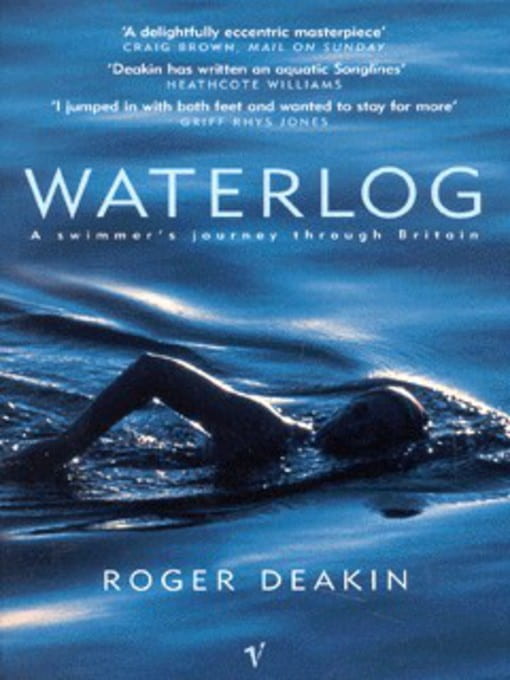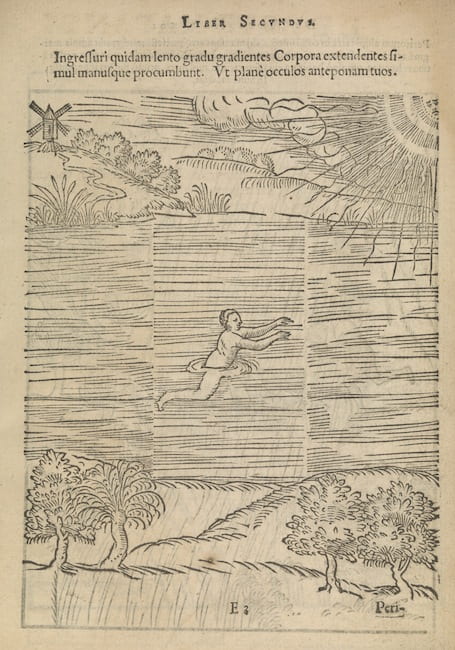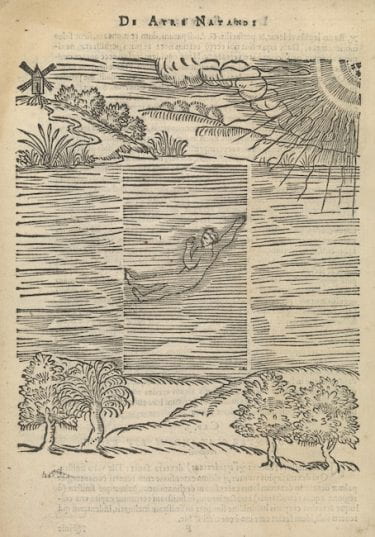By Luna Sarti

Several recent publications in the environmental humanities discuss the need for new ways of experiencing and imagining the world around us, with the aim to free ourselves from what Ursula K. Le Guin called the “one-way future consisting only of growth” (A Non-Euclidean View of California as a Cold Place to Be). In the hopes of forging a new (possibly less gloomy) future, scholars across disciplines, from art and landscape studies to field biology, call for slower practices of knowledge that can train us “to pay better attention” and to recover “those pasts we need to see the world more clearly” (Arts of living on a damaged planet G1-2). Walking has become an increasingly popular practice for fostering slowness and for attuning individuals to new ways of experiencing the world and to the forgotten histories embedded in our physical landscapes, particularly in socially engaged art. Less common, but equally interesting, is the idea to turn to swimming as a way to explore waterscapes and regain the perception of our environments as terraqueous assemblages. In Waterlog (2000), filmmaker and writer Roger Deakin provides readers with a wonderful example of what it means to re-imagine life from inside waters.
It is an intriguing vision which exhorts us to recognize how learning processes train us to see certain things, while others are assigned to the background and thus remain blurred. Compared to other practices, swimming certainly allows us to unsettle the contemporary land-centered attitudes that tend to dominate institutional education and scholarship. However, one might wonder how to translate the concept of swimming into practice. Contemporary swimming techniques are, in fact, another byproduct of modernity and were developed in order to make the human body move as fast and efficiently as possible when in water.
Swimming seems to be an unusual object of history, but it is indeed a product of history. In its most common understanding, leisure swimming in pools and the sea, using standard techniques such as breaststroke, free style, backstroke, and butterfly is actually the result of specific political and cultural processes. Although humans have a long history with waters and references to swimming appear in different civilizations and throughout various sources, contemporary techniques have only recently been standardized according to criteria that are largely based on modern re-readings of Roman swimming traditions and that foster ideas of speed and efficiency when the human body is placed in water.

A few scholars have engaged in recovering ancient and pre-modern cultures of swimming, most noticeably Ralph Thomas (1905), Nicholas Orme (1983), Richard Mandell (1984) and Jean-Paul Thuillier (2004). Historian Jean-Paul Thuillier discusses how only the Romans, and not the Greeks, practiced swimming, drawing on Grimal’s suggestion that “a transformation in the sporting habits occurred in Rome, with swimming taking over from racing or wrestling”, as the presence of water in training fields seems to indicate (421). According to Orme, there is no doubt that swimming was in use among the Germanic peoples during the years of Caesar and that it was not only practiced but also praised across Roman, Germanic, and Norse civilizations. From the evidence and the analyses presented in the works on the history of swimming, it seems reasonable to state that in most cases swimming was given a higher status when associated with martial practices.
The most extensive references to swimming do, in fact, occur in texts describing military history or training, most noticeably in Plutarch and Suetonius, who both recount episodes in which Caesar’s heroism and strength emerge through his extraordinary swimming skills. Such a connection between swimming and heroism characterizes also Vegetius’ Epitoma Rei Militaris, in which the ability to swim is described as necessary for soldiers, not only to cross rivers in the absence of bridges but also in the case of sudden floods (Book 1, chapter 10).
There certainly is an incredibly high number of references to swimming practices across authors as different as Caesar, Horace, Cato the Elder, and Seneca. In most cases, swimming does imply a specific way to engage with waters which is associated with what we might describe as ‘Promethean undertakings’, either over the physical environment or against less skilled enemies. At times, one can deduce swimming practices of the time, for example in his Astronomica, Manlius seems to describe something similar to butterfly and breaststroke (Vol. 5, p. 422).
Now lifting one arm after the other to make slow sweeps he will catch the eye as he drives a furrow of foam through the sea and will sound afar as he thrashes the waters; now like a hidden two-oared vessel he will draw apart his arms beneath the water; now he will enter the waves upright and swim by walking and, pretending to touch the shallows with his feet, will seem to make a field of the surface of the sea; else, keeping his limbs motionless and lying on his back or side, he will be no burden to the waters but will recline upon them and float, the whole of him forming a sail-boat not needing oarage (Translated by G. P. Goold).
Although no Latin author appears to have written a major work of instruction on the subject, and thus it is hard to assess what the word swimming (natare) meant at the time, the examples above seem to suggest that the concept was often associated with strength, conquest, and human mastery.
Interestingly enough, in medieval times there seems to emerge a tendency to depreciate the status of swimming for the same reasons that make it valuable in most Latin texts. It has also been observed how the section on swimming in Vegetius’ treatise is sometimes omitted in medieval copies (Chaline 101). Such a tendency is particular evident in both the tradition of biblical commentary and in courtly literature. Authors such as Gregory the Great and Bartholomeus Anglicus stress the dangers of water and minimize the human ability to survive in the element by his own exertions whether one can swim or not. Moreover, while Caesar and the heroes of Northern sagas are described as excelling in this practice which plays a significant role in their heroic achievements, the heroes of the chansons de geste and the romances are rarely or never depicted as swimming. According to Orme, swimming is rarely attributed to the knightly heroes of medieval tradition, and “was indeed seen rather as alien and incompatible with their usual behaviour” (33).

Historians of swimming agree in identifying a significant change in attitudes towards the practice during the 16th century when swimming is mentioned in educational literature and manuals on the subject start to circulate. Swimming is variously discussed in treatises such as The governor by Sir Thomas Elyot (1531), Castiglione’s Il libro del Cortegiano (1528), The schoolmaster by Roger Asham (1564) and Richard Mulcaster’s Positions (1581). According to Thomas and Orme, the first work to be entirely devoted to swimming was Wyman’s Colymbetes, sive de arte natandi: dialogus et festivus et iucundus lectu (1538), in which Wyman explains how to swim using the popular form of a dialogue between two characters, Pampirus and Erotes. However, the first illustrated treatise on the practice is considered to be Everard Digby’s De arte natandi, which appeared in England in 1587 and describes both how and where to swim.
Although it has been observed how 16th-century swimming theories targeted literate nobility and gentry, and largely evolved as analytical speculation on the ‘ideal forms of swimming’ which might have had little influence on contemporary swimming practices, it is still significant that such a theoretical interest developed in the first place. European theorists began, in fact, to publish treatises on swimming in a time that is marked by overseas expansion, human mastery, and colonialism.
In an essay entitled Enslaved Swimmers and Divers in the Atlantic World, historian Kevin Dawson has recently demonstrated how the interest in swimming that characterizes the 16th century is entangled with overseas expansionism, extraction economy, and violence. Not only did Europeans employ a high number of ‘enslaved divers’ in the Americas to collect pearls and to recover goods from sunken ships, drawing on native populations first and later on Africans, but they also looked at the swimming techniques of these skilled slaves who adopted variants of the freestyle which were unknown to Europeans. Such a connection between colonialism, slavery, and the development of swimming techniques casts another troublesome shade on the process that lead to the formation of standardized swimming styles.
It is perhaps ironic that a practice which is now associated either with leisure or forms of ‘returns to ecological statuses’ seems to have been fostered into higher social status and standardization not only in relation to conceptions of health and physical force, but also in association with practices of conquest and dominance, either over the physical world or other populations. As a swimmer and a strong believer in practices of care (as theorized for engaged environmental humanities), I wonder what implications this history has in the way we approach swimming and if this affects what we see from and inside the water. Perhaps it is an irrelevant question, but – should we be reconsidering the way we swim?
Luna is a Ph.D. candidate in Italian Studies at the University of Pennsylvania. Her research explores the shifting cultures and practices of water that bound the Arno river in Florence. In her dissertation, she analyzes site-specific medieval and early modern narratives of flooding to discuss if, when, and how flood is to be considered a “natural disaster.”
Featured Image: Woodcut from Everard Digby’s De arte natandi.




May 21, 2019 at 4:50 pm
Something else to read is Arnd Kruger’s essay, “Swimming and the Emergence of the Modern Spirit,” in McClelland and Merrilees (eds) Sport and Culture in Early Modern Europe, Toronto 2009, pp. 407-29
May 21, 2019 at 5:35 pm
You mention that swimming virtually disappeared from medieval texts. I think this is because it was viewed as utilitarian (you imply this) and therefore not suitable for the aristocracy (the literate class). In fact, in the tale Puss in Boots, the marquis de Carabas convinces the king he is of the nobility precisely because he can’t swim… In France, swimming is seen as a popular sport, something J-J Rousseau suggested should be taught instead of equestrian exercises, because swimming was useful where riding a horse was rarely a question of life and death. So contemporary swimming may have something of a mixed pedigree: a symbol of colonial oppression or higher social status in some places, while elsewhere a popular sport linked to republicanism and public health. I wonder, too, about swimming in Hungary where it was linked to national identity and where water polo, in particular, became a symbol of resistance against the Soviet Union. Ultimately, I think the symbolic currency depends on when and where swimming is/was described.
May 24, 2019 at 5:45 am
This is wonderful. ps. The French anthropologist/sociologist Marcel Mauss wrote about the cultural and social making/shaping of all kinds of bodily activities like swimming, about navy sailors unable to swim and so on, in his 1935 long essay “Techniques of the Body.” Various translations exist, such as in _Techniques, technology and civilisation_ / Marcel Mauss ; edited and introduced by Nathan Schlanger. New York: Durkheim Press/Berghahn Books, 2006, pp. 77-96.